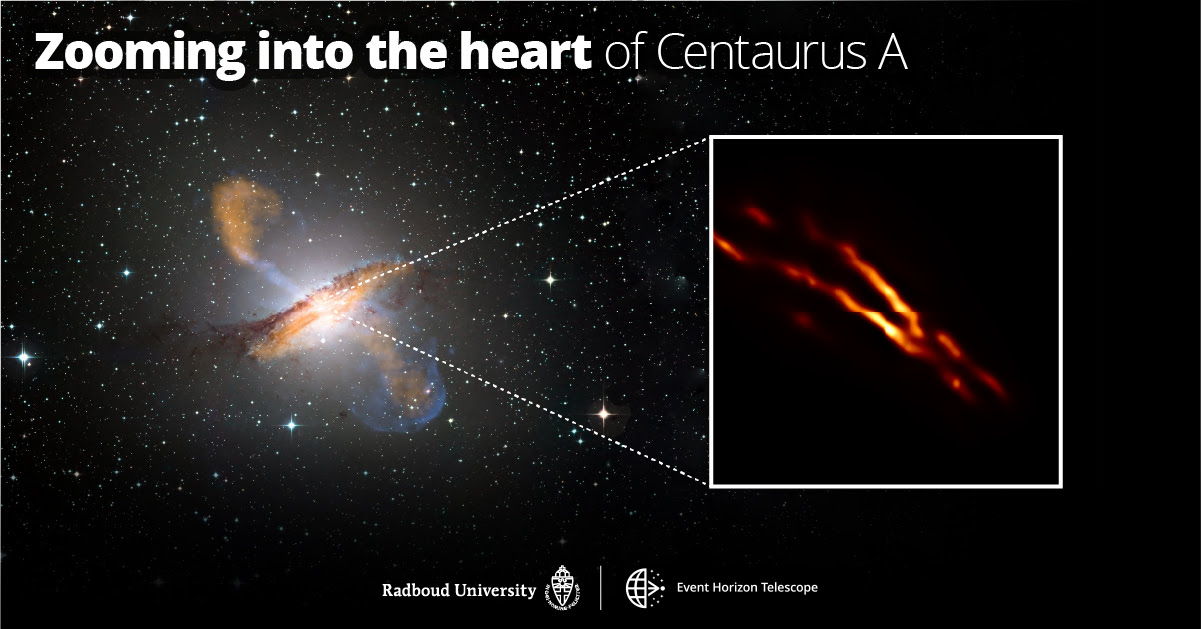Hawaii Telescopes Help Pinpoint Dark Heart of Nearest Radio Galaxy
At radio wavelengths, Centaurus A is one of the largest and brightest objects in the night sky, showing extended jet and giant radio lobes. After it was identified as one of the first known extragalactic radio sources in 1949, Centaurus A has been studied extensively across the entire electromagnetic spectrum by a variety of radio, infrared, optical, X-ray and gamma-ray observatories. At the center of Centaurus A lies a black hole with the mass of 55 million suns.
In a new paper published Monday in Nature Astronomy, data from the 2017 Event Horizon Telescope (EHT) observations have been analyzed to image Centaurus A in unprecedented detail.
“This allows us for the first time to see and study an extragalactic radio jet on scales smaller than the distance light travels in one day. We see up close and personal how a monstrously gigantic jet launched by a supermassive black hole is being born,” says astronomer Michael Janssen of the Max Planck Institute for Radio Astronomy and Radboud University.
Compared to all previous high-resolution observations, the jet in Centaurus A has now been imaged at a tenfold higher frequency and sixteen times sharper resolution. With the resolving power of the EHT, astronomers can now link the vast radio lobes, or jets, of the source — which are 16 times the angular diameter of the Moon on the sky — to their location of origin in the center of the Centaurus A galaxy. This central region that hosts the supermassive black hole appears tiny in comparison; it is merely the size of an apple on the Moon when projected on the sky. This is a magnification factor of one billion.
“First Pōwehi, and now particle jets!” says Jessica Dempsey, deputy director of the James Clerk Maxwell Telescope (JCMT) in Hawaii, which helped capture the new images. “Four nights of EHT observing in 2017 continue to revolutionize black hole physics — it is and will continue to be one of the most powerful tools we have for seeing our hidden and most extreme universe.”
Simon Radford, director of the Submillimeter Array (SMA), another Hawaii observatory that participated in the observations, says, “This research showcases the close cooperation between observatories in Hawaii and elsewhere. The SMA and the JCMT have participated in the EHT for more than a decade. They will continue to play a major role in future EHT observations because of their location, their technology and the dedication of their talented staff.”

Understanding jets
Supermassive black holes that reside in the center of galaxies like Centaurus A feed off gas and dust that is attracted by their enormous gravitational pull. This process releases massive amounts of energy and causes the galaxy to become ‘active.’ Most matter lying close to the edge of the black hole falls in. Some of the surrounding particles, however, escape moments before capture and are blown far out into space, creating jets — one of the most mysterious and energetic features of galaxies.
Astronomers have relied on various models of how matter behaves near black holes to better understand this process. But they still do not know exactly how jets are launched from their central region and how they can extend over scales that are larger than their host galaxies without dispersing.
The EHT aims to resolve this mystery.
The new image released today shows that the jet launched by Centaurus A is brighter at the edges compared to the center. This phenomenon is not new but has never been observed so pronounced in a jet before.
“Hawaii telescopes deliver great results for the Event Horizon Telescope again, this time showing the fountaining of a powerful beam of particles from very close to a supermassive black hole,” says Geoffrey Bower, Hawaii chief scientist for the Academia Sinica Institute of Astronomy and Astrophysics and project scientist for the EHT. “We’re looking forward to following this powerful system over the years to come.”
Future observations
The researchers predict that future observations at an even shorter wavelength and higher resolution will be able to photograph the central black hole of Centaurus A. This will require the use of space-based satellite observatories.
“These data are from the same observing campaign that delivered the famous image of the black hole in M87. The new results show that the EHT provides a treasure trove of data on the rich variety of black holes and there is still more to come”, says Heino Falcke, EHT board member and professor for astrophysics at Radboud University.
Sponsored Content
Comments








